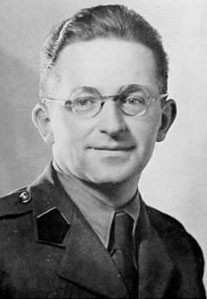-
(b.) -1905 August 16(d.)1980 February 13
Bio/Description
A Polish mathematician and cryptologist who in 1932 solved the plugboard-equipped Enigma machine, the main cipher device used by Germany. His success, along with his colleagues Jerzy R?życki and Henryk Zygalski jump-started British reading of Enigma in World War II; the intelligence so gained, code-named "Ultra", contributed, perhaps decisively, to the defeat of Nazi Germany. Born in Bromberg, now Bydgoszcz, his parents were J?zef, a cigar merchant, and Matylda, n?e Thoms. He attended a German-speaking K?nigliches Gymnasium zu Bromberg (Royal Grammar School in Bromberg) and completed high school with his matura in 1923. He then studied mathematics at Poznań University, graduating with a Master's Degree on 1 March 1929; his thesis was titled, "Theory of double periodic functions of the second and third kind and its applications." A few weeks later, without having completed the cryptology course, he began the first year of a two-year actuarial statistics course at G?ttingen, Germany. He would not complete the actuarial-statistics course, for, while home for the summer in 1930, he accepted the offer of a mathematics teaching assistantship at Poznań University. While studying mathematics at Poznań University, he had attended a secret cryptology course conducted by the Polish General Staff's Biuro Szyfr?w (Cipher Bureau), which he joined full-time in 1932. The Bureau had achieved little success reading Enigma and in late 1932 set him to work on the problem. After only a few weeks, he deduced the secret internal wiring of the Enigma. He and his two mathematician colleagues then developed an assortment of techniques for the regular decryption of Enigma messages. His contributions included devising the cryptologic "card catalog," derived using his "cyclometer," and the "cryptologic bomb." Five weeks before the German invasion of Poland in 1939, he and his colleagues presented their results on Enigma decryption to French and British intelligence representatives. Shortly after the outbreak of war, the Polish cryptologists were evacuated to France, where they continued their work in collaboration with the British and French. They were again compelled to evacuate after the fall of France in June 1940, but within months returned to work undercover in Vichy France. After the country was fully occupied by Germany in November 1942, He and fellow mathematician Henryk Zygalski fled, via Spain, Portugal and Gibraltar, to Britain. There they worked at a Polish Army unit, solving low-level German ciphers. In 1946, he returned to his family in Poland and worked as an accountant, remaining silent about his cryptologic work until 1967. In ?Turing?s Cathedral? by George Dyson it is noted that he, along with Jerzy R?zycki, and Henryk Zygalski, ??assisted by French intelligence and an interest in the German Enigma dating back to an interception by Polish customs officers in 1928, narrowed the search for rotor configurations so that electromechanical devices (called ?bombas? by the Poles and ?bombes? by the British) could apply trial and error to certain subsets that remained.?
-
Date of Birth:
1905 August 16 -
Date of Death:
1980 February 13 -
Gender:
Male -
Noted For:
Solver of the plugboard-equipped Enigma machine, the main cipher device used by Germany -
Category of Achievement:
-
More Info:


